
Australian critic, poet, and TV personality Clive James died last week. The author of many books (including Cultural Amnesia, which included appreciations of modern artists and thinkers, and a tribute to Philip Larkin), reviews, as well as pieces on Princess Diana, Arnold Schwarzenegger, and much, much more, James was funny, insightful, and deeply influential. A 2003 profile of James by A.O. Scott was titled “The Hungriest Critic of All.” According to Leo Robson in the New Statesman: “The writer I wanted to learn from was Clive James.” His writing is “alive in every phrase,” says Adam Gopnik in the New Yorker. “He made you laugh; he made you think; he made you feel—and then he made you laugh again, at the limits of your own thoughts to articulate your feelings, compared with his fluent capacity for articulating his.”
British historian and novelist Lucy Adlington has sold her narrative history The Dressmakers of Auschwitz to Harper for a reported six figures. The book, due out in 2021, “tells the powerful true story of the extraordinary young women and teenagers who were saved from the gas chambers to sew haute couture dresses at a tailoring studio within the Auschwitz-Birkenau concentration camp.”
Tomorrow (December 3) at the New York Public Library, rock critic Robert Christgau (author of, among other titles, Grown Up All Wrong, Going to the City, and Book Reports) will join jazz critic Gary Giddins (Weather Bird, Bing Crosby) in what promises to be a lively conversation about books and music.
Hilton Als weighs in on Joan Didion’s first three novels: Run River, Play It as It Lays, and A Book of Common Prayer. “A Book of Common Prayer is an act of journalistic reconstruction disguised as fiction: a Graham Greene story within a V. S. Naipaul novel, but told from a woman’s perspective, or two women’s perspectives, if you believe [the narrator] Charlotte, which you shouldn’t.”
The New York Times Magazine profiles Pete Hamill, the newspaper legend and author of books such as Why Sinatra Matters and A Drinking Life. Hamill—who has written around 9,000 articles and once ran the New York Post even after he was fired—has moved back to Brooklyn to finish his twenty-second (and “possibly his last”) book, Back to the Old Country, a “reminiscence about the borough that shaped him.”